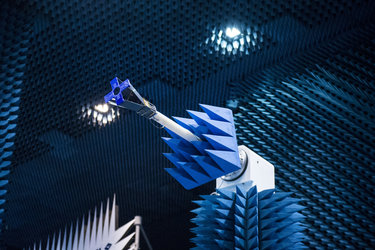Outstanding International Achievements for the OPS-SAT Mission Control Team
The OPS-SAT Mission Control Team (MCT) has been instrumental in realising the world’s first mission dedicated to improving mission operations. The team was awarded the 2023 International SpaceOps Award for Outstanding Achievement at SpaceOps 2023. Many congratulations to the team.
This is their story.
Created and operates the world’s first mission dedicated to improving space operations allowing rapid experimentation of mission critical processes on an open, flying laboratory - SpaceOps 2023 Award Citation

As early as 2012, the ESOC Future Studies Section realised that cubesat technology was going to significantly lower the barrier to accessing space and they decided to propose a mission where operations were at the heart of the mission. They called the project “The Operations Satellite” i.e. OPS-SAT. Its objective was simple: allow in-flight experimentation on critical operations processes which are normally off-limit and thereby accelerate innovation in the domain. As they evolved the concept, they realised that to the ground, such a satellite would have to look exactly like an advanced ESA spacecraft to be credible. At the same time it would have to be robust to all sorts of normally mission ending errors and finally, to allow as much experimentation as possible, it would have to be completely reconfigurable after launch.
After a four-year development phase, the OPS-SAT MCT launched the satellite into low earth orbit from Kourou on December 18th 2019. It had the honour of being the first nanosatellite owned and operated by ESA.
Despite a difficult start that extended the commissioning phase to nine months, the MCT quickly achieved the prime mission of demonstrating many brand-new communication protocols lined up for future ESA missions. They then turned their attention to turning the mission into a flying laboratory - coining the term OPS-SAT Space Lab. The main experimental control processor is powerful enough to run normal software (e.g. Java & Python) meaning experimenters do not need embedded software skills to control the satellite. The MCT extended this idea and developed a preloaded software framework that allows experimenters to control the spacecraft by loading software in an “App” like way, further expanding the reach. At the other end of the spectrum, they developed software and documentation to re-task the powerful reconfigurable FPGA (normally a very risky operation) on which experimenters could base their own projects. On the ground side, the mission control system was opened to allow experimenters to perform their own command and control of the spacecraft by simply connecting up to ESOC when it passes over Darmstadt, Germany.
Each member of the MCT was encouraged to become an OPS-SAT experimenter so they could experience the process first hand and make incremental improvements where possible. Successful MCT led experiments include implementing TCP/IP over SpaceWire on a raw LVDS wire in flight, training and uploading a TensorFlowLite AI model to classify OPS-SAT pictures and the inflight demodulation and decoding of search and rescue messages sent from ships in distress.
Experiments can be submitted from any space agency, European company, research or educational institute and the number has continuously grown over time. There are now 221 activities covering every aspect of mission control and type of organisation. Space Agencies such as ESA, CNES, DLR and JAXA, large primes such as Airbus Defense & Space and OHB, government organisations such as the EU commission, educational institutions such as MIT and Oxford university and a multitude of start-ups, research institutes and new entrants. Information on how to become an experimenter can be found here. There is even a Frankfurt bank, FlatexDegiro, who extended their trading network onto OPS-SAT to perform the world’s first stock market trade in space.
The MCT have been instrumental in achieving this success and have not stopped there. After realising that the in-built robustness of the lab could be exploited to allow untrained students to safely interact directly with the satellite, they have integrated OPS-SAT into many university level and ESA courses, bringing the excitement of live operations directly into the classroom. OPS-SAT Space Lab is now working in collaboration with the ARTES Scylight programme on extending the offering with a follow-up spacecraft that will allow experimentation on optical ground to space and quantum based communication.















 Germany
Germany
 Austria
Austria
 Belgium
Belgium
 Denmark
Denmark
 Spain
Spain
 Estonia
Estonia
 Finland
Finland
 France
France
 Greece
Greece
 Hungary
Hungary
 Ireland
Ireland
 Italy
Italy
 Luxembourg
Luxembourg
 Norway
Norway
 The Netherlands
The Netherlands
 Poland
Poland
 Portugal
Portugal
 Czechia
Czechia
 Romania
Romania
 United Kingdom
United Kingdom
 Slovenia
Slovenia
 Sweden
Sweden
 Switzerland
Switzerland
































